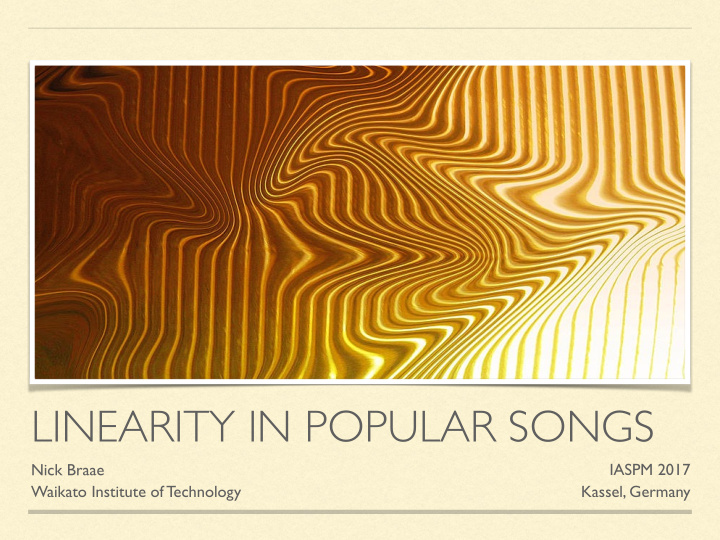



LINEARITY IN POPULAR SONGS Nick Braae IASPM 2017 Waikato Institute of Technology Kassel, Germany
MUSIC AND TIME ‘Music unfolds in time. Time unfolds in music’ (Kramer 1988) ‘All music creates an order of virtual time, in which its sonorous forms move in relation to each other’ (Langer 1953: 109-110) Music ‘constructs in actual time, its own special artistic time, musical, dramatic, or narrative’ (Sauvage 1958: 162) Musical time: the nature of the metaphorical journey we travel in engaging a work from start to finish
MUSIC AND MODES OF TEMPORALITY Linear (goal-directed) time — musical events exist in a causal relationship with each other; progression towards a goal Non-directed linear time — musical events exist in a causal relationship with each other; sense of progression/momentum but without a clear goal Multiply-directed time — musical events progress towards multiple goals concurrently; attainment of goals separate Vertical time — no apparent progression; stasis Moment time (moment form) — self-contained episodes of distinct musical material Classical music (18th/19th C repertoire) and linear time through harmonic-structural processes
TIME IN POPULAR MUSIC Compositional approaches (e.g. accumulative form, Spicer 2004; also Holm-Hudson 2002; Nicholls 2007; Malawey 2011) Genre/artist studies (e.g. post-millennial rock, Osborn 2011, 2013; also Neal 2007; Zak 2008; Liu-Rosenbaum 2012; Mercer-Taylor 2013) Specific musical elements (e.g. rhythmic interplay, Hesselink 2014; also Walser 1995; Butler 2001; Danielsen 2006; Pieslak 2007; Covach 2010; Nobile 2011; McCandless 2013; Hesselink 2014)
TIME IN POPULAR MUSIC What musical traits contribute to different temporal experiences in a popular music context? How can specific styles be understood with reference to categories of musical time? How can categories of musical time be used to complement existing terminology and approaches for understanding song form, in both simple and complex contexts?
POPULAR SONGS, LINEARITY, AND VERTICALITY Linear (goal-directed) time: causal relationships between musical events…cf…vertical time: stasis, unchanging musical events Popular song as occupying states between linearity and stasis (Moore 2001) State-of-becoming (linear) vs. state-of-being (static); progression ‘into’ the groove (Danielsen 2006)
THE CLIMAX AND ‘KISS’ 12-bar blues structure Moderate tempo/slow harmonic rhythm ‘Unpredictable titillations, moans, and caresses’ in Prince’s vocal Release of sexual/musical energy in final verse
THE CLIMAX AND ‘PURPLE RAIN’ Primary chord loop (I-vi-V-IV); clear verse and chorus sections Development of emotional intensity through successive verses and choruses (allusion to emotional authenticity? See Moore 2002) More activity in bass line (walking pattern every second bar) Prince’s wordless melody = the climax The performance of each section develops from the previous material
‘EVERY PICTURE TELLS A STORY’ ‘THE KILLING OF GEORGIE’ Ruptures/disjunctures in musical events ‘Every Picture Tells a Story’: descriptive tale; asymmetric I-bVII-IV-I loop Drop into a straight boogie on D; transformation of drums from syncopated kick/snare pattern to four-to-the-floor/backbeat groove; emphasise the ‘moral’ of the new lyric ‘The Killing of Georgie’: descriptive tale; constant I-iii-IV pattern Coda: modulation to Eb, change in tempo/harmonic pattern; illuminates the emotional core of the song
CONCLUSIONS: THE CLIMAX IN POPULAR SONG Non-harmonic/thematic climax in ‘Kiss’ and ‘Purple Rain’ Other examples of textural/melodic/lyrical climaxes: ‘Stairway to Heaven’ (Led Zeppelin; texture), ‘Silver Springs’ (Fleetwood Mac; vocality), ‘Lover, You Should Have Come Over’ (Jeff Buckley; melody), ‘Somebody to Love’ (Queen; melody), ‘My Way’ (Frank Sinatra; texture/groove), ‘L-O-V-E’ (Nat King Cole; texture), ‘Solsbury Hill’ (Peter Gabriel; texture), ‘Baba O’Reilly’ (The Who; groove/tempo)
CONCLUSIONS: THE DENOUEMENT CODA Introduction of new material at the end of song; comments musically or lyrically on preceding material ‘Layla’ (Derek and the Dominoes), ‘Rock and Roll Suicide’ (David Bowie), ‘Bohemian Rhapsody’ (Queen), ‘My Fairy King’ (Queen), ‘Liar’ (Queen), ’Thunder Road’ (Bruce Springsteen), ‘Jungleland’ (Bruce Springsteen), ‘Estranged’ (Guns N’ Roses), ‘November Rain’ (Guns N’ Roses)
POPULAR SONGS AND TIME REVISITED Confluence, juxtaposition and layering of static and development musical features: concurrently contrasting modes of temporality The ‘quest’ narrative and classical music; still aspects of a ‘quest’ in popular song but articulated and presented differently Similarities in the types of metaphorical stories across idioms; differences in how these stories are told
Recommend
More recommend